Easy Radish Kimchi (Kkakdugi)
The crisp and crunchy radish kimchi, popularly known as kkakdugi, is a staple in Korean cuisine. With this easy 20-minute kkakdugi recipe, you can effortlessly make authentic-tasting radish kimchi that rivals the flavors of top Korean restaurants.
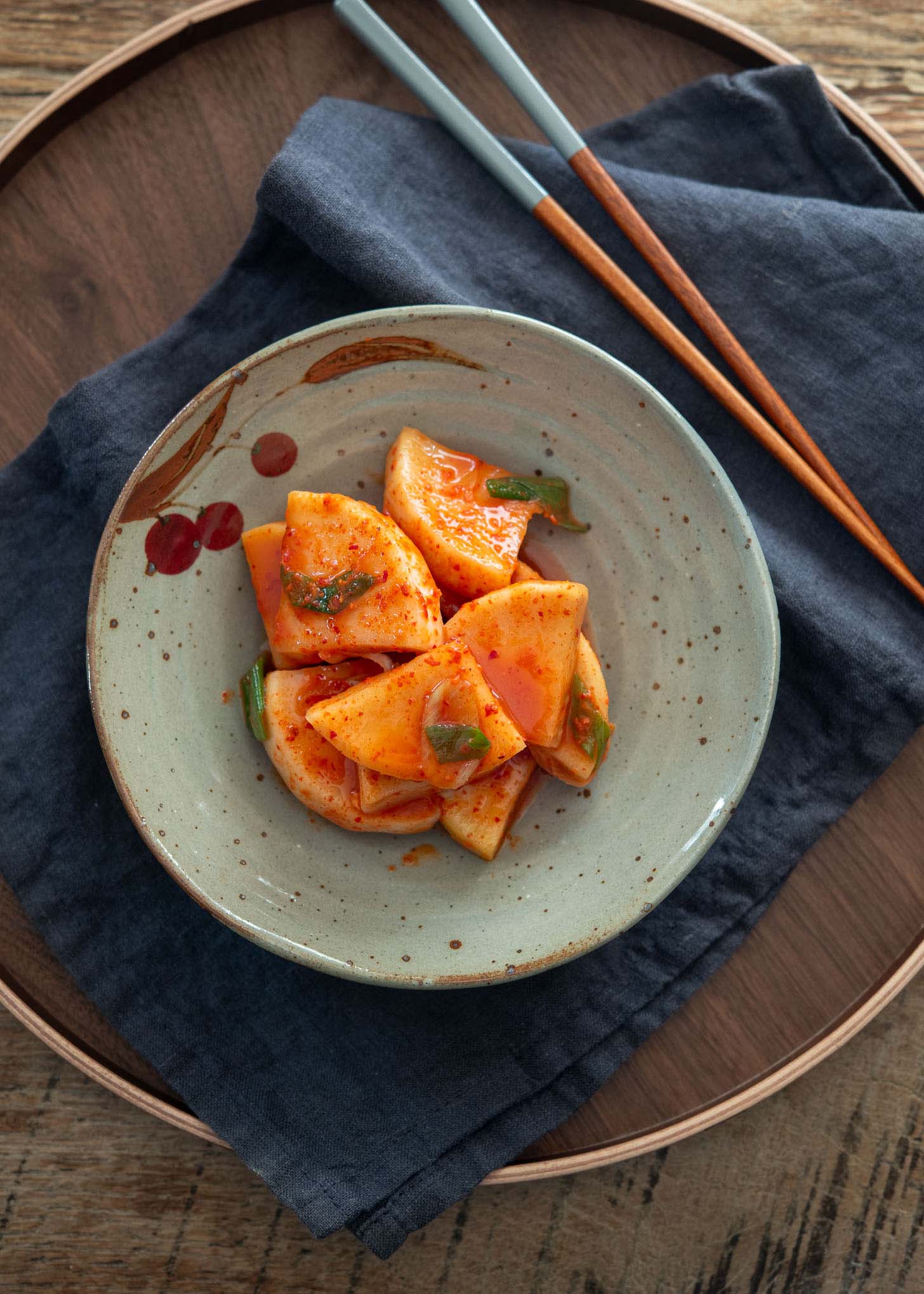
When fall deepens, Koreans begin making a radish kimchi called kkakdugi. I vividly remember my mom making large batches of kkakdugi kimchi every year from October to December to enjoy throughout the colder months.
When it’s fully fermented, this Korean radish kimchi, known as Seokbakji Kkakdugi, tastes even better than the famous napa cabbage kimchi or other varieties of kimchi. Its crunchiness is so tempting, and once you try it, you just can’t get enough!
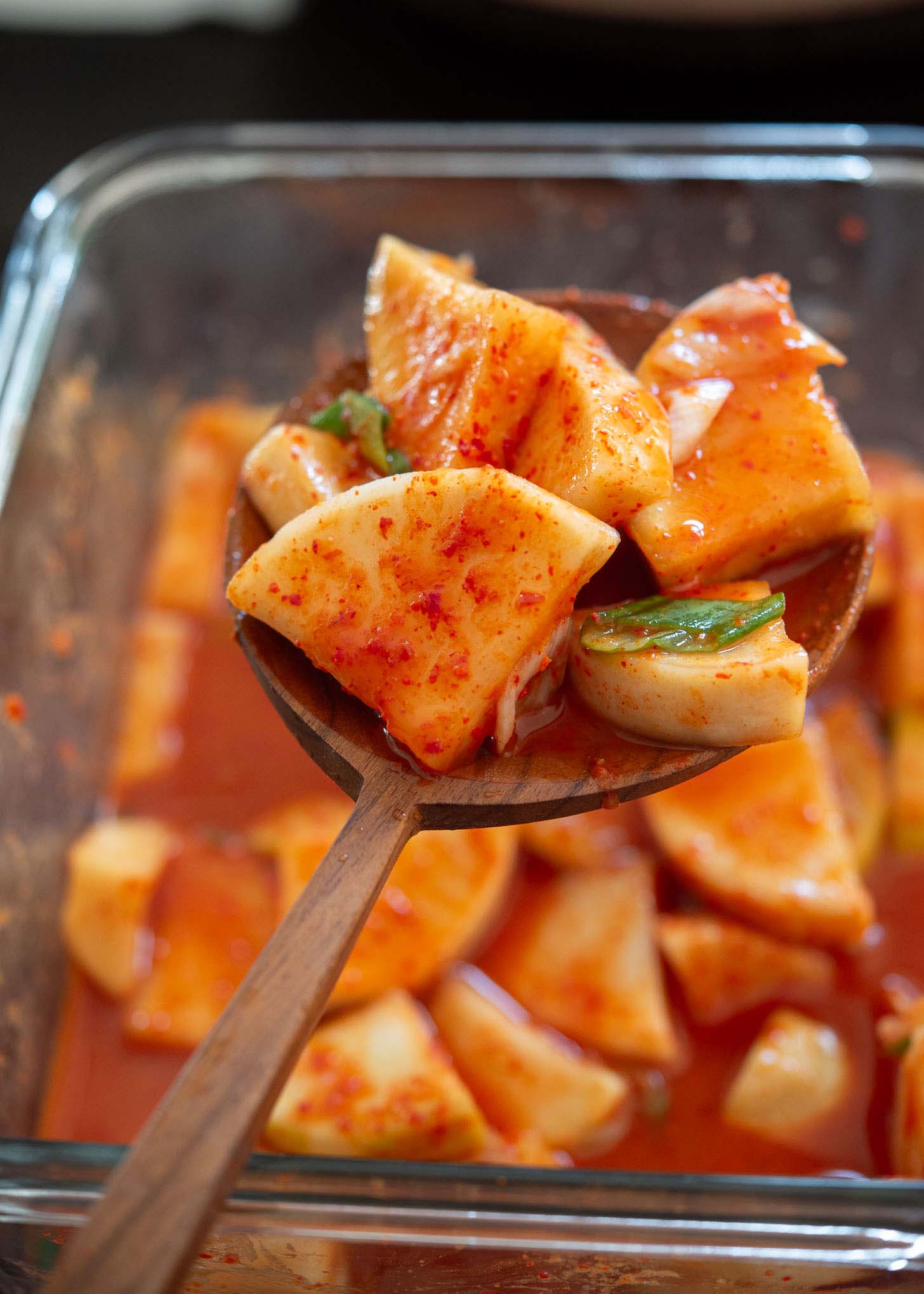
What is Kkakdugi?
Kkakdugi is a type of kimchi made from cubed or sliced radishes. The name “kkakdugi (깍두기)” comes from the Korean word for the cube shapes.
These radish cubes or slices are seasoned with ingredients like chili pepper, garlic, and green onions, giving kkakdugi its signature spicy and tangy taste along with a crunchy texture. Personally, I lean towards sliced kkakdugi over cubed, primarily because that’s what I grew up with in the Southern region of Korea.
In Korean cuisine, people often enjoy kkakdugi alongside other foods. It goes great with several Korean dishes, including:
- Seolleongtang (ox bone soup)
- Kkori-gomtang (Korean oxtail soup)
- Galbitang (beef short rib soup)
- Kalguksu (knife-cut noodles)
Korean Radish
Korean radish, or mu (무), is a white radish variety renowned for its crisp texture and a flavor profile that blends subtle sweetness with a peppery kick. It’s best in cool seasons, becoming sweeter in fall and winter.
It’s perfect for many Korean recipes, including beef radish soup and mackerel radish stew. Summer-harvested counterpart tends to carry a bitter taste.
When Korean radish is unavailable, daikon radish serves as an substitute. While the taste and texture of daikon may slightly differ from the traditional Korean mu, it maintains a decent crispness and taste compatible with various recipes.
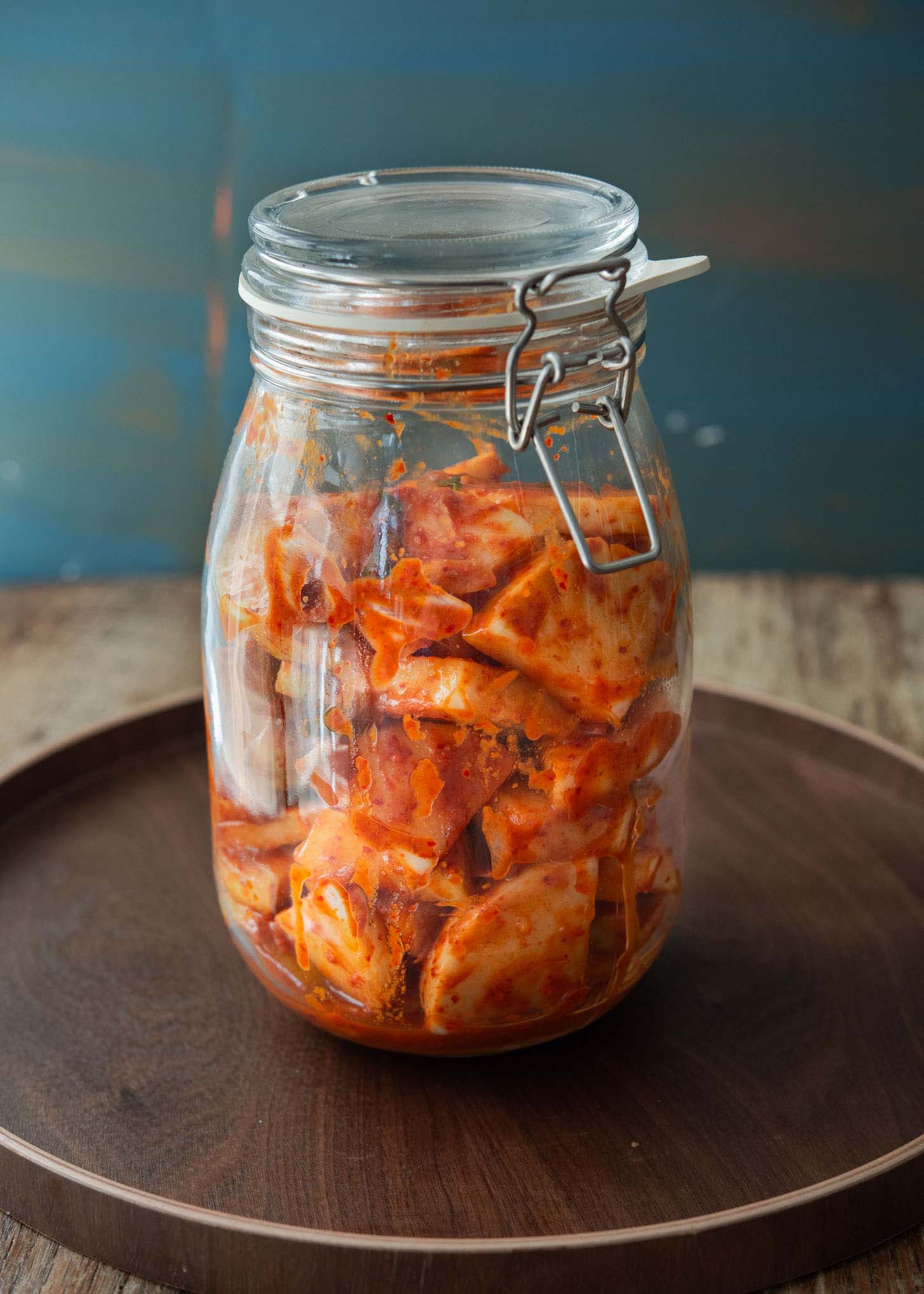
Unique Features of This Radish Kimchi Recipe
This kkakdugi recipe offers a streamlined approach to traditional radish kimchi, achieving the classic taste with less effort. No need soak or make rice flour paste — You can whip up a batch in just 20 minutes.
- No Salting Required: Unlike other recipes that require salting radish to draw out moisture, this simplified method lets you dive straight into mixing with the kimchi seasoning. This approach not only speeds up the kimchi-making process but also lets you quickly prepare a batch.
- As it ferments, the radish naturally releases moisture, resulting in a savory brine that contributes to the kimchi’s distinctive sharp, yet refreshing flavor.
- Incorporation of Carbonated Drink: Utilizing a carbonated drink is a popular trick that Korean restaurants use when making kkakdugi. The soda’s sugar and carbonation speed up the fermentation, while its sweetness offsets the spice, contributing to a richer flavor profile.
- Additionally, the soda enhances the kimchi’s texture, ensuring it remains crisp and vibrant in color.
- Versatility in Shape: While cubed radish is standard for kkakdugi, some prefer slicing it into flat triangles for an old-fashioned look known as Seokbakji Kkakdugi.
- This style is purely preferential, and the recipe accommodates either, allowing you to maintain the traditional cubed appearance if desired.
Ingredients
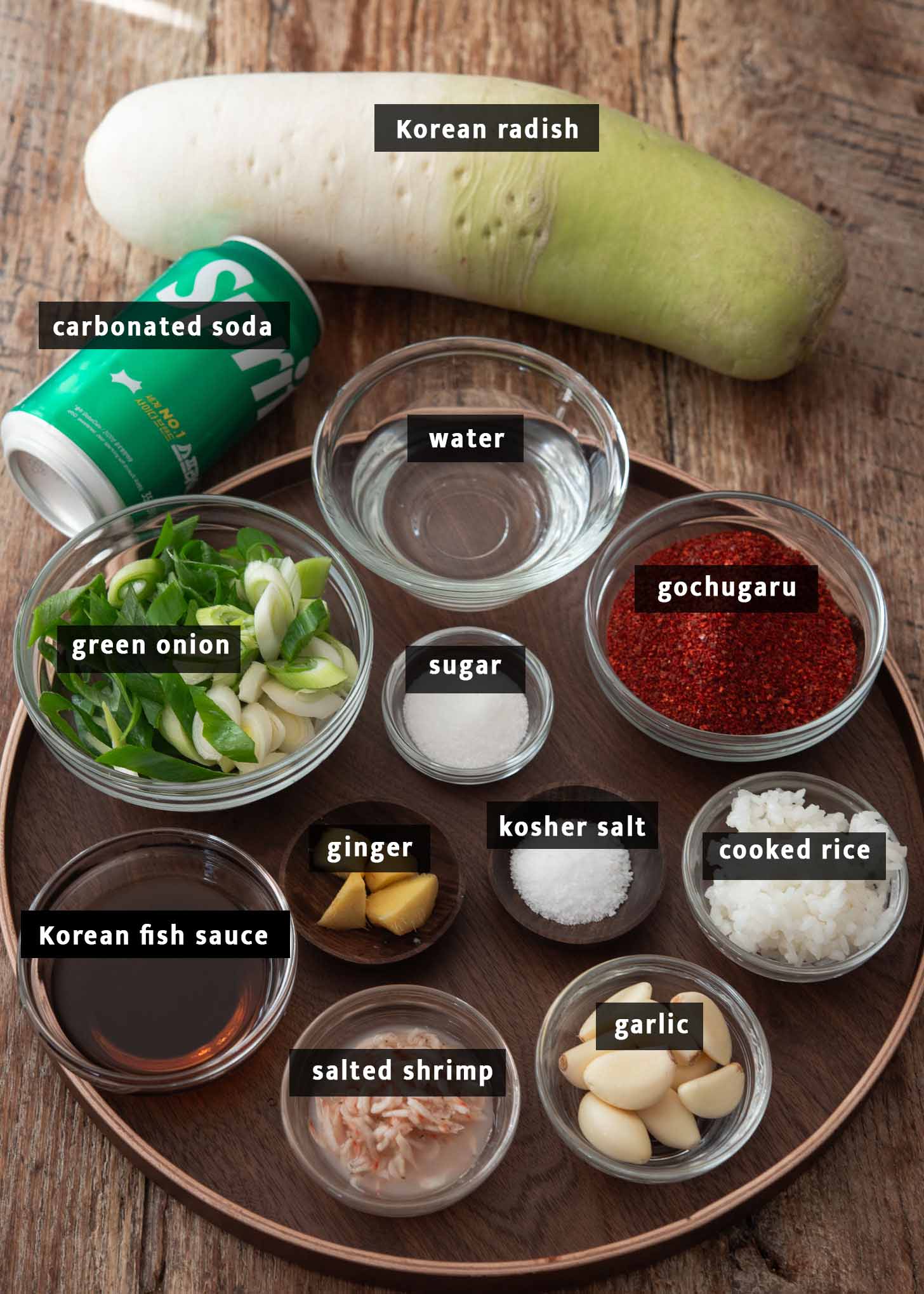
- Korean radish (Mu): When choosing a Korean radish, select one that is firm, has smooth, bright skin, and is medium-sized for optimal flavor and texture.
- If leaves are attached, they should be vibrant green, indicating freshness – great for ponytail radish kimchi.
- Green onion: Adds a mild, zesty flavor and a pop of color to the mix. Asian leek is a good substitute.
Kkakdugi kimchi seasoning:
- Korean red pepper flakes (gochugaru): This gives the kimchi its signature heat and vibrant red color.
- Korean fish sauce (anchovy sauce): Infuses the mix with savory depth and umami richness.
- Salted shrimp: Contributes a briny flavor without a unique seafood tang.
- Garlic, ginger: These are key aromatics, contributing a warm, spicy kick.
- Sugar: Slightly sweetens the mix and helps start the fermentation process.
- Cooked white rice: Acts as a binder for the seasoning and aids in fermentation.
- Salt: for overall seasoning. Use Korean coarse sea salt or kosher salt.
- Carbonated lemon-lime soda: Creates a fizzy brine, quickens fermentation, and adds a subtle sweetness.
How to make radish kimchi (kkakdugi)
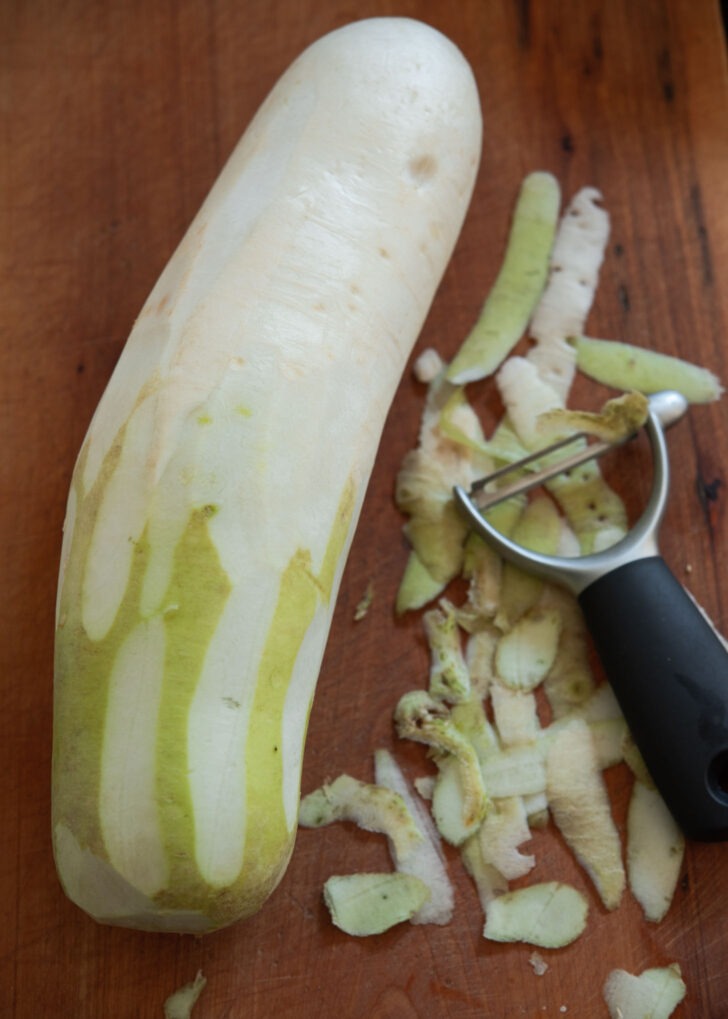
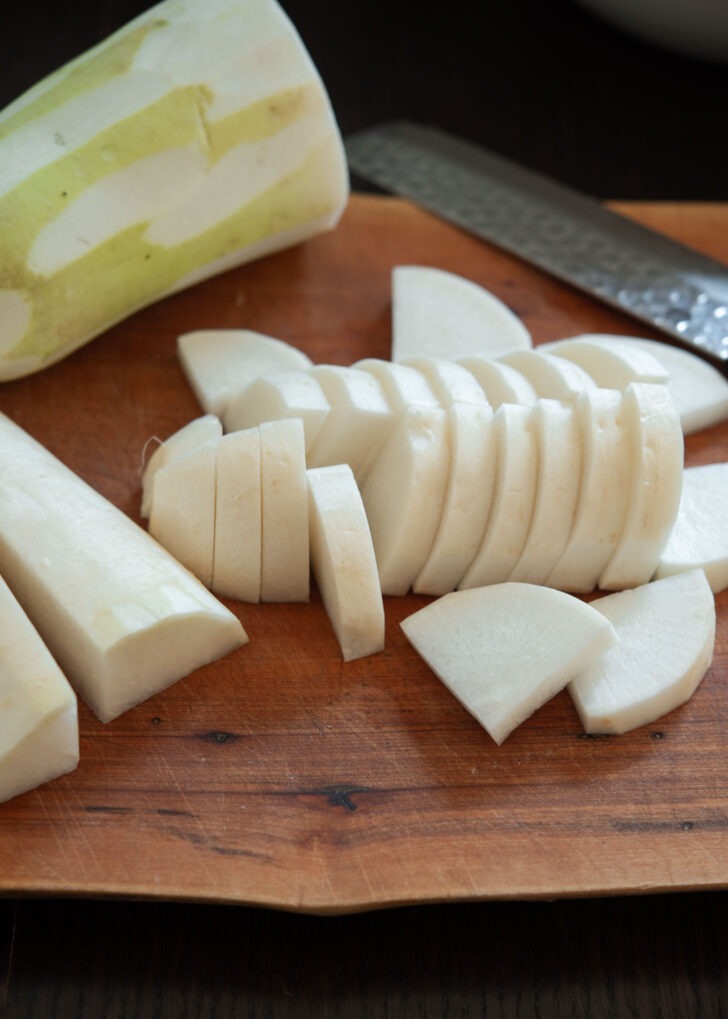
Step 1. Radish Preparation
- For fresh radishes with smooth skin, give a light peel. If the skin is thicker, remove it completely.
- Slice the radish with a knife into 1/2-inch thick disks, then quarter each disk. Transfer the radish pieces to a large mixing bowl and set aside.
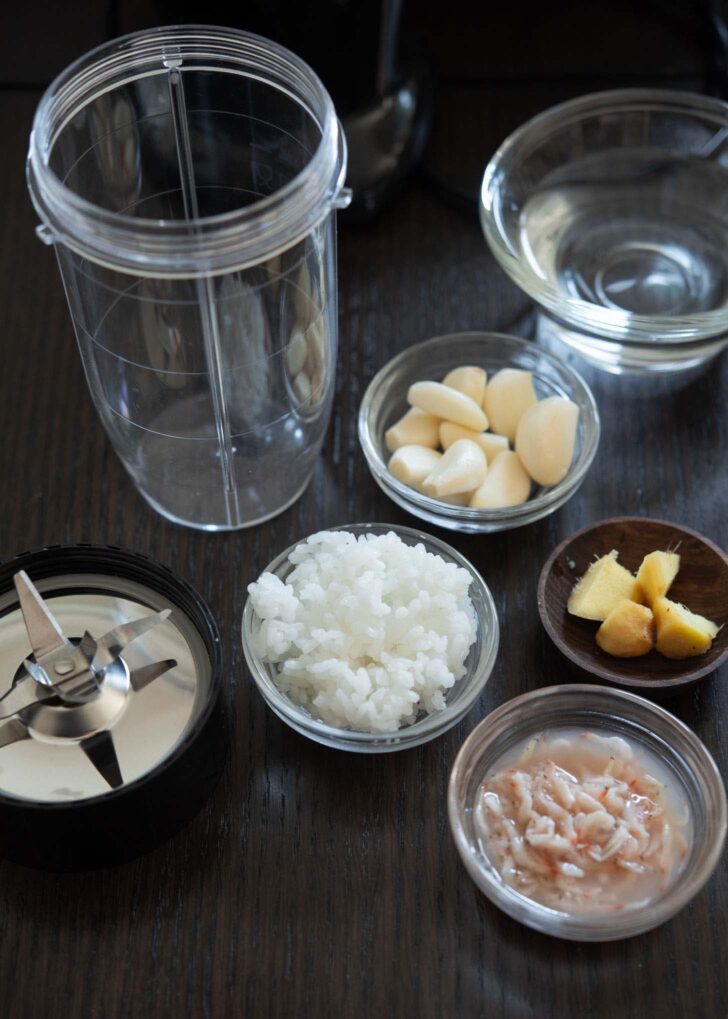
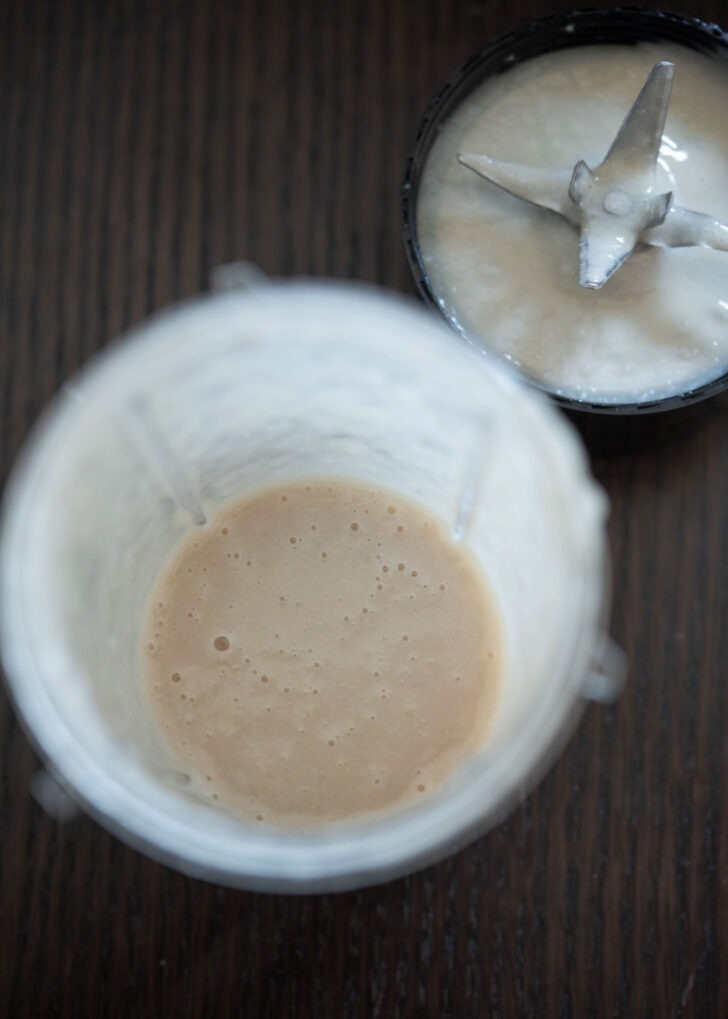
Step 2. Blend the seasoning ingredients
- Combine garlic, ginger, salted shrimp, cooked white rice, and 1/4 cup water in a blender or food processor.
- Process until you achieve a smooth, slightly liquid consistency.
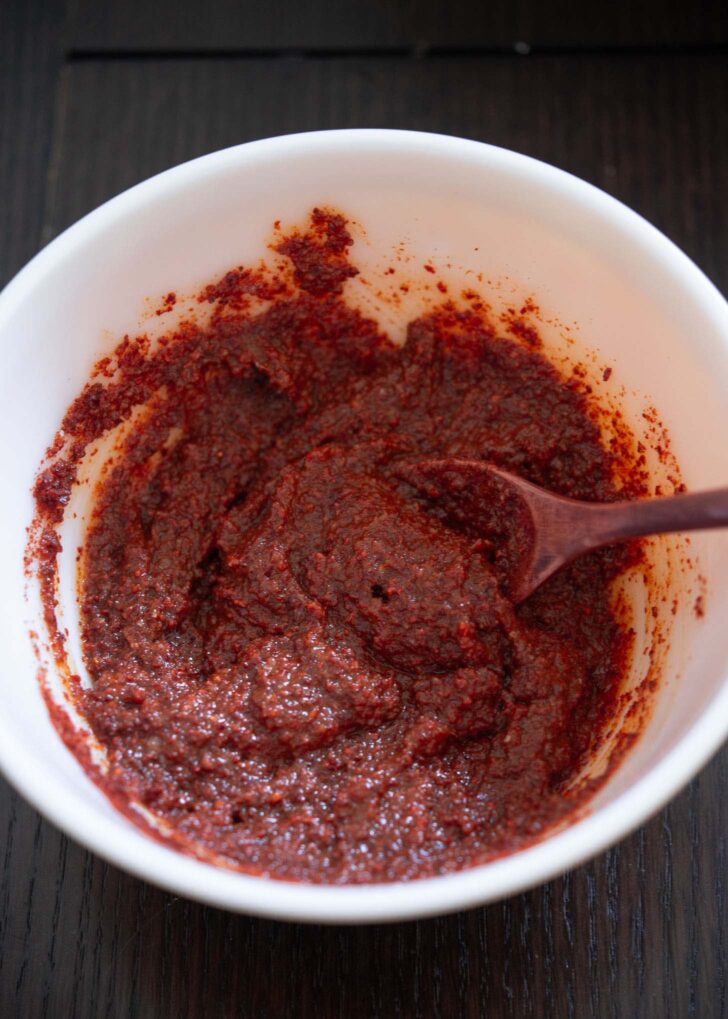
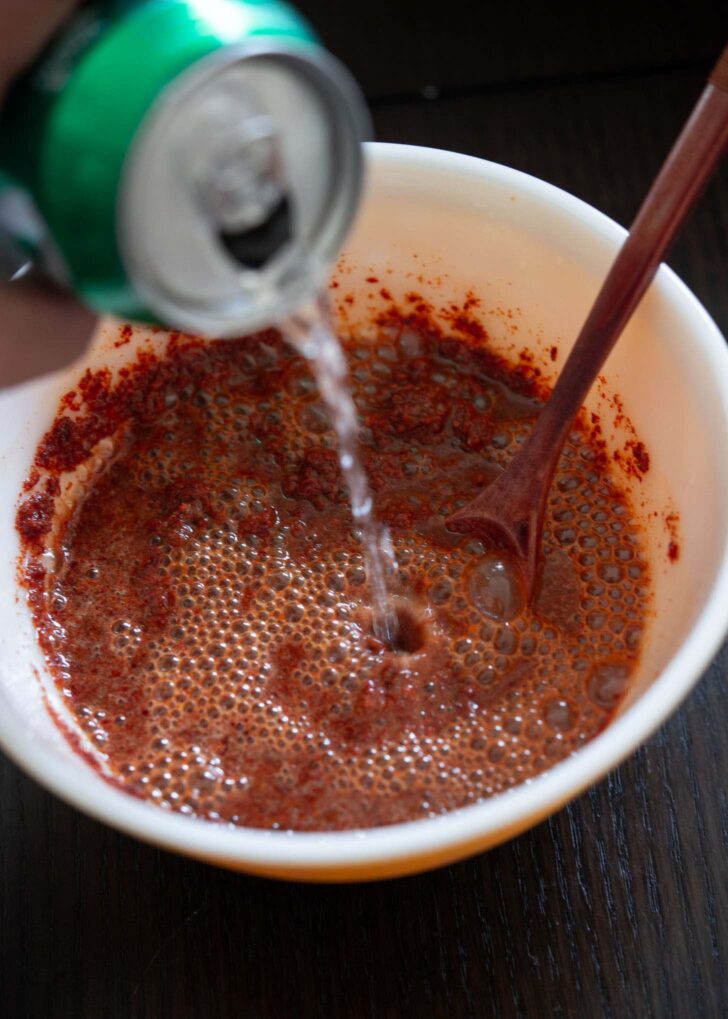
Step 3. Make kimchi seasoning paste
- Move the paste to a mixing bowl. Mix in the Korean chili flakes, sugar, fish sauce, and salt.
- Pour in the carbonated drink and combine thoroughly.
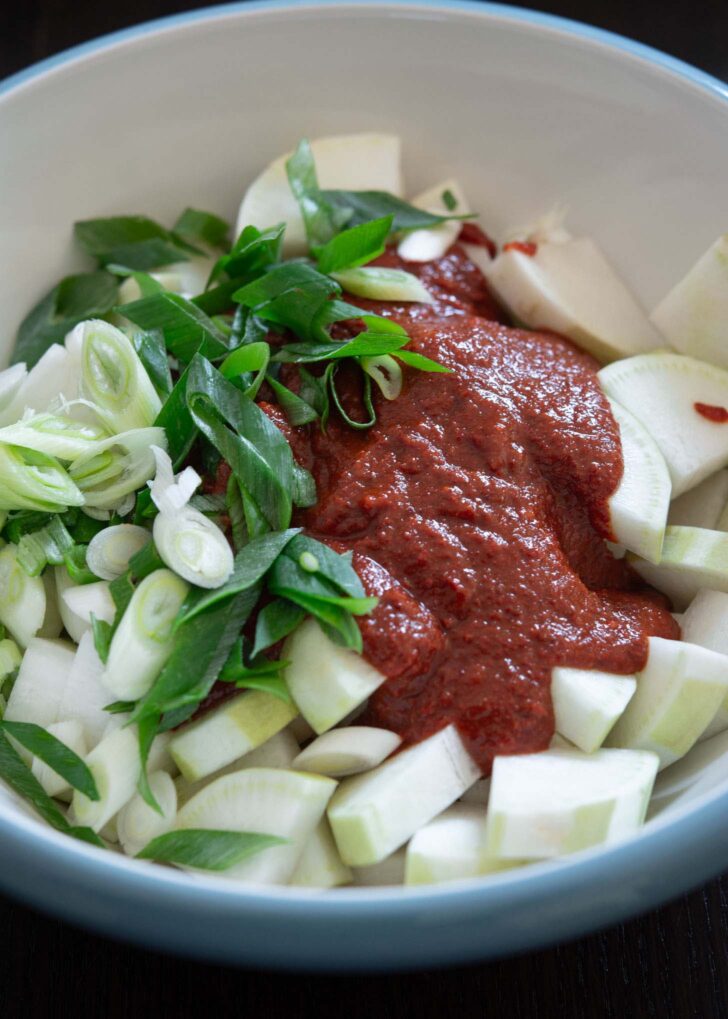
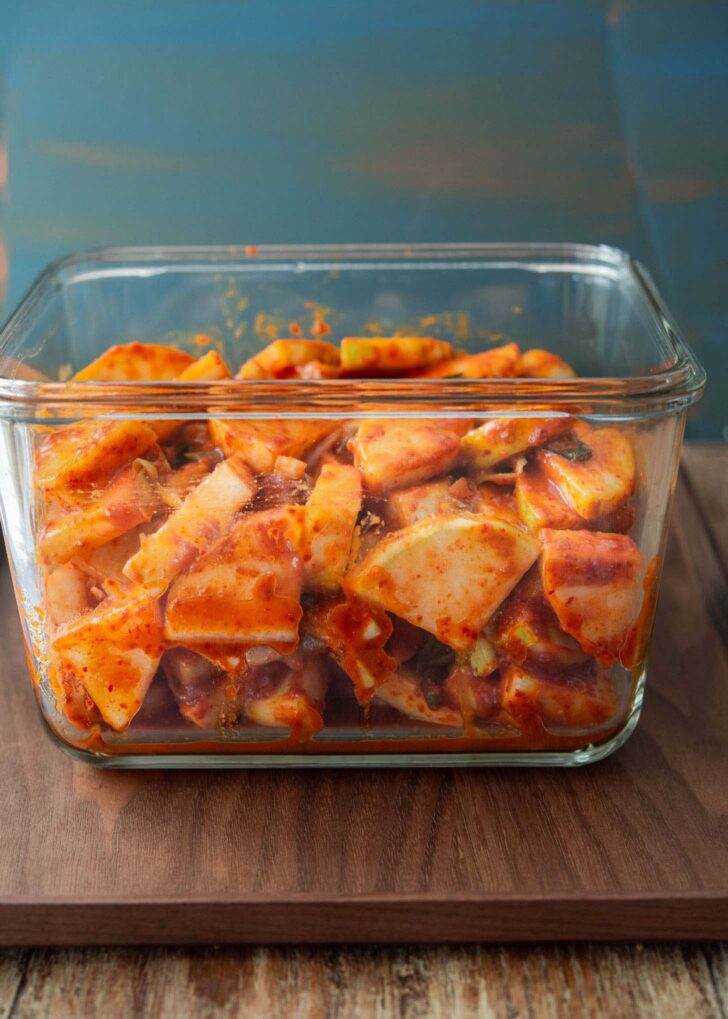
Step 4. Mix radish with seasoning
- Mix green onion with the radish in the bowl. Drizzle the seasoning paste over the mixture, stirring to coat each piece uniformly.
- While the seasoning might appear excessive, it’ll balance out during fermentation.
- Store the radish kimchi in a sealed container or jar.
To ferment
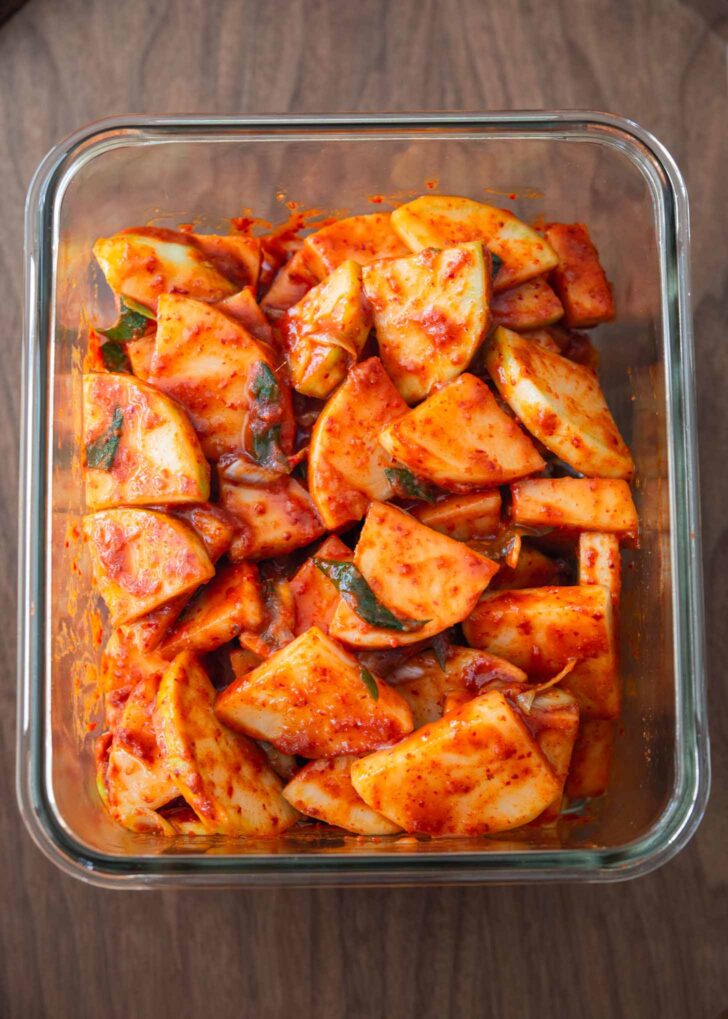
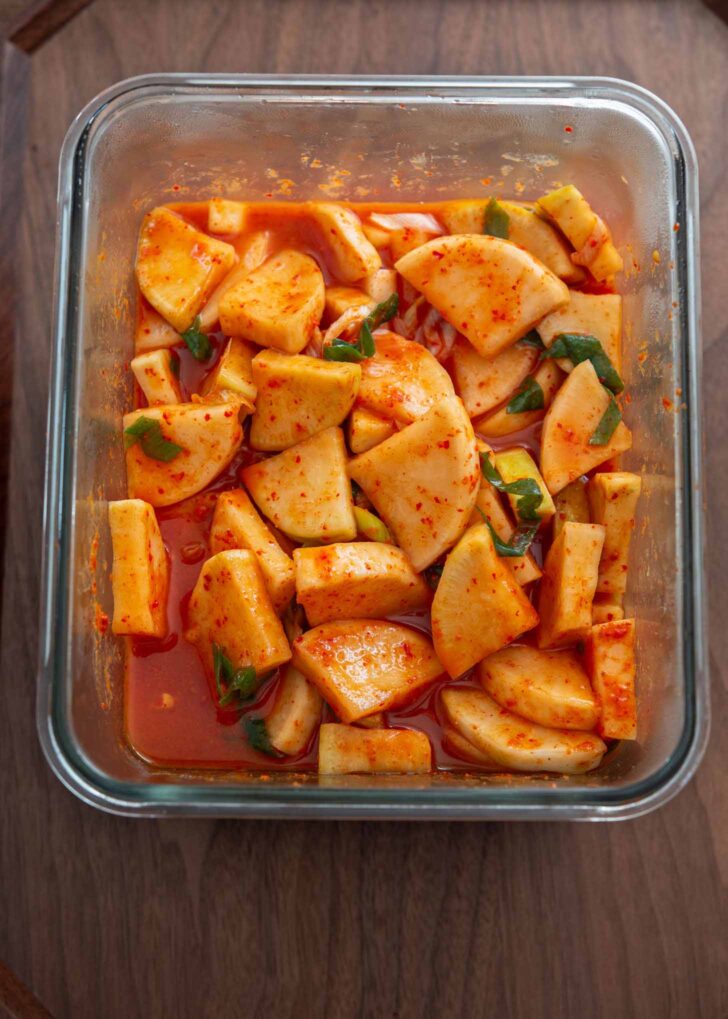
- Let the kimchi rest at room temperature for 2-3 days. You’ll see gas bubbles emerging on top.
- The radish will shed some water, thinning the seasoning as it ferments—this is expected and good!
- After this period, give it a good mix and refrigerate for another 3-5 days.
- By the end, your homemade kimchi should have a vibrant orange-red color with a tangy flavor and a crisp bite.
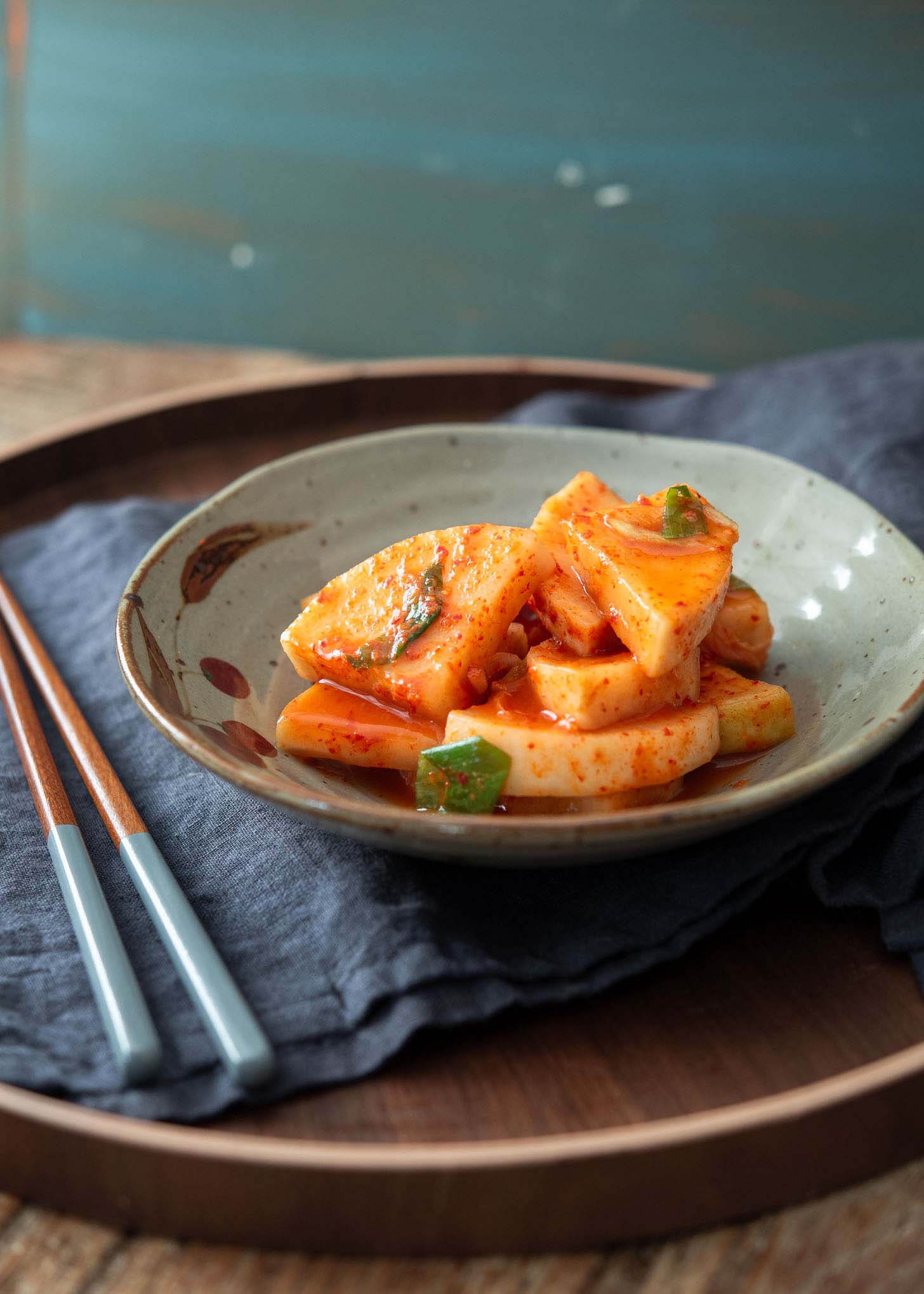
How long does radish kimchi last?
Kkakdugi typically lasts for several weeks if stored properly. When kept in the refrigerator in an airtight container, it can stay fresh for up to two to three months.
However, the flavor and texture will change over time. It will continue to ferment slowly in the refrigerator, becoming more sour and pungent.
Whether kimchi has fermented too long is usually up to personal taste, but it’s safe to eat unless there are signs of spoilage like mold, an unusual smell, or a slimy texture. Always trust your senses when evaluating the freshness of food.
Serving Suggestions
Kkakdugi is the ideal side dish (banchan) for a wide range of Korean meals, complementing everything from rice and noodle dishes to stir-fries, soups, and stews. In addition to the bone-marrow soup and other soups mentioned earlier, consider pairing it with these Korean dishes:
- Bibimbap (Korean Mixed Rice Bowl)
- Bulgogi (Korean BBQ Beef)
- Samgyupsal (Pork Belly BBQ)
- Gyeran Bap (Korean Egg and Rice)
- Mandu Guk (Dumpling Soup)
- Miyuk Guk (Seaweed Soup)
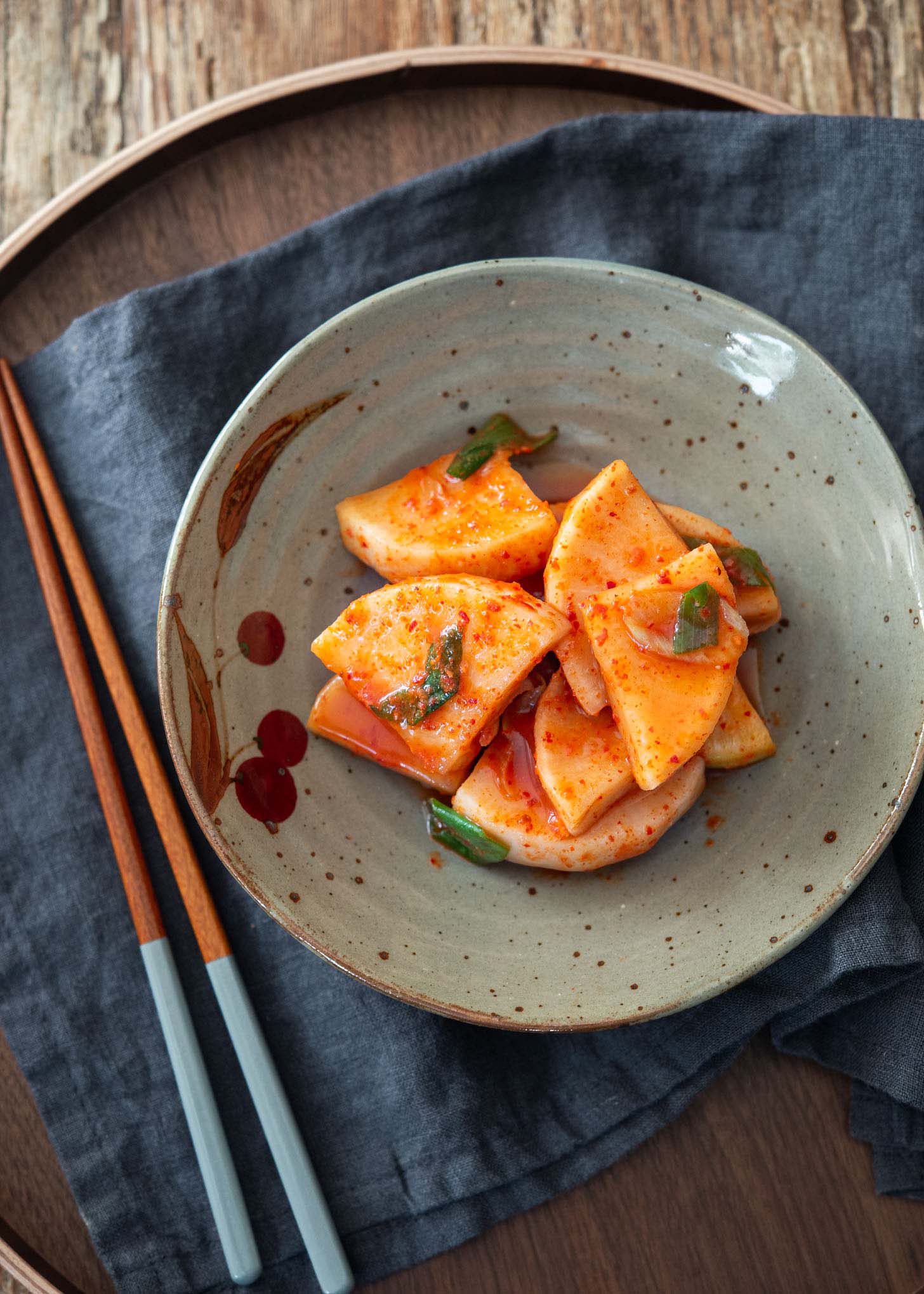
This recipe was originally published on January 16, 2013. Updated and republished for more information and accuracy. Please rate it and share your experience in the comments below! For more delicious recipes, subscribe to our newsletter!
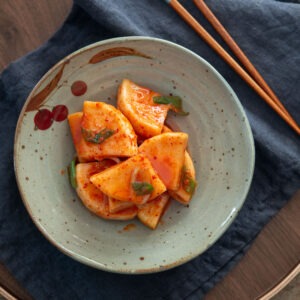
Easy Radish Kimchi (Kkakdugi)
Recipe Video
Ingredients
- 2 3/4 lb (1.3 kg) Korean radish, or daikon radish
- 3-4 stalks green onion, chopped
For kkakdugi seasoning paste
- 10 cloves garlic
- 1 inch ginger, peeled and roughly chopped
- 2 tbsp cooked white rice
- 1 1/2 tbsp salted shrimp
- 1/4 cup (60 ml) water
- 6 tbsp Korean chili flakes (gochugaru)
- 1 tbsp sugar
- 3 tbsp Korean anchovy sauce
- 2 tsp kosher salt
- 2/3 cup (160 ml) carbonated soda (lemon-lime flavor)
Equipment
- airtight glass container about 1 gallon in volume
Instructions
Prepare the radish
- If your radish is fresh and the skin is smooth, peel it lightly. For thicker skin, peel it off entirely. Cut the radish into 1/2-inch thick disks and then quarter each disk. (Alternately you can cut into 1-inch cubes) Place the radish pieces in a large mixing bowl and set it aside.
Make kkakdugi seasoning paste
- In a blender or food processor, combine garlic, ginger, salted shrimp, cooked white rice, and 1/4 cup of water. Blend until the mixture forms a smooth, slightly runny paste. Transfer the paste to a mixing bowl.
- Stir in Korean chili flakes, sugar, fish sauce, and salt. Add the carbonated drink and mix everything well.
Mix radish with seasoning
- Add green onion to the bowl with the radish. Pour the seasoning paste over the radish and onion mixture, mixing well to ensure all pieces are evenly coated. The seasoning may seem excessive, but it will distribute more evenly as the radish ferments.
- Transfer the radish kimchi into an airtight container or glass jar for storage.
To ferment
- Let the kimchi sit at room temperature for 2-3 days, depending on the room temperature. You'll notice gas bubbles forming on the surface. As it ferments, the radish will release excess water, diluting the seasoning slightly — this is a positive sign! After 3 days, stir the mixture well and then move it to the refrigerator. Let it continue fermenting for another 3-5 days. By the end of this period, your homemade kimchi should have a bright orange-red hue, a refreshing and slightly sour taste, and retain a crisp, crunchy texture.


Am a big kimchi fan and loved this. The carbonated soda is a new kitchen hack for me, but it worked. This has fantastic flavor and crunch. I just went to a newly opened Korean restaurant in my town and, though am happy to have the restaurant, this kimchi was better. Do Korean restaurants dumb down their recipes for American tastes?
I’m glad you enjoyed the recipe! Regarding the Korean restaurant you mentioned, their authenticity might vary based on their main clientele. If most of their customers are non-Koreans, they might adjust the flavors to suit those tastes. My tip? Look for a Korean restaurant frequented by Koreans themselves. That’s the same strategy I use to find authentic spots for any world cuisine!
Hi, Holly. I’ve made this radish kimchee and it has been a hit! Your cucumber kimchee was also a crowd favorite! Just curious if it would make a difference to salt the radish before making the kimchee and if so, would I need to adjust anything else in the recipe? Thanks for your advice.
Hi Michiko
If you prefer to salt the radish beforehand, toss it with about 1/4 cup of coarse sea salt and let it sit for 1 hour. Afterwards, rinse the salt brine off with water and drain well. Skip the salt to the kimchi seasoning paste. When mixing the radish with the paste, taste it first and then add extra salt according to your preference. Hope this helps. Thanks!
Thank you so much for your quick and detailed response! I am going to try this right now. Even without salting beforehand, this is hands down my favorite recipe. Friends ask me for the recipe all the time.
Thanks,
Michiko
Hi Holly, I’m curious about the function of the Sprite other than for sweetness. Will leaving it out affect the flavour and texture?
Hi Jeanne
Adding a carbonated drink, such as Sprite, to radish is one of the many methods used to brine the vegetable. It doesn’t affect the flavor or texture negatively. Instead, it imparts a bit of sweetness to the radish as it brines.
Amei a sua história sobre o seokbakji…cheguei a sua página porque vi numa série (Hometown cha-cha-cha) e sempre que vejo as comidas dos restaurantes nestes filmes fico salivando…kkk
Se eu tivesse dinheiro com certeza realizaria meu sonho de conhecer estas iguarias…como não tenho me contento em comprar uma pitada pelo site nas lojas daqui do Brasil…
Do you add water to cover all the radish during fermentation? Or is it okay if the liquid does not cover the radish?
No, you should not cover the radish with water all the way. You will need a small amount, about 1/2 – 1 cup to wash out the remaining kimchi seasoning in the mixing bowl that you used to assemble the kimchi in. Then just pour the water over the radish kimchi.
It is in reality a great and useful piece of info.
I am glad that you just shared this helpful information with us.
Please keep us up to date like this. Thanks for sharing.
I made the radish kimchi on Monday night, the radish used is not Korean just using local radish. On the 3rd night the radish has a bitter taste, do you know why? The crunchy texture is very good just wondering why a bitter taste. Recipe has 3 cloves of garlic / small size ginger / half apple & pear / 4 stalks of spring onion & chinese parsley / Koran chilli powder / 2 tbs salt & sugar
Chinese Parsley is too strong to use in kimchi and it may cause the bitterness in the flavor. Also depends on the type of radish, some is more bitter than the other. Korean radish is somewhat sweeter than other kind.
Thanks! I will strictly follow the recipe coming Sat (your recipe) and finger cross to get the same good taste ; ))
Can I use the plum extract in this recipe? I see that you used it in your 30minute kimchi recipe and I’m very curious about the plum extract 🙂 If so, how much would I use and would I need to omit anything?
Sure you can. Use about 2 tablespoon and omit the sugar in the recipe.
Hello Holly! Im so happy you are back and feeling better! My name is aspyn, i had a question, i bought some radish kimchi and it was super crisp but i had to put it in a different container and after a day in the fridge its kind of soggy and limp. Is there a way to keep this from happening? With purchased or homade radish kimchi?
Hi Aspyn, radish kimchi doesn’t stay fresh that long unlike cabbage kimchi. However always store your kimchi in a airtight container to avoid air contact. Usually if radish kimchi gets too fermented it looses its crunch texture. If you kimchi seems going fermented fast, place egg shell (cleaned and wrapped in cotton or cheese cloth) in the kimchi. The shell will neutralize the acidity of kimchi and slow down the fermentation a little bit.
Ok i will try that thank you so much!!!!
Thank you for this recipe. How much sweet rice flour and water should I use to make this if I don’t want to use potatoe?
Mix about 3 tablespoon rice flour with 1/2 cup water and bring to boil and simmer to thicken up. Cool slightly and use about 3-4 tablespoonful of this rice glue to add to the kimchi filling.
Good article. I absolutely appreciate this site. Stick with it!
Hi Holly,
I just took your 3 part instruction on kimchi. Sitting on my counter now are two beautiful glass jars of homemade kimchi- I had extra filling and radish so I made an impromptu additional batch.
Thank you for the inspiration! I will let you know how it turns out.
Matt from Miami FL
Hi Matt
That is so awesome! Cheers to you!
I do hope you like the taste. I am sure your kimchi will ferment very well in Florida. 🙂
Thank you.
I LOVE Korean food so I’m so happy to find your site!!! My roommate in university was Korean and her mom always made us Kimchi. My absolute favourite was the radish kimchi and I can never find it in stores. So happy to have found a recipe!!!
Just wondering if the 1 tablespoon anchovy sauce is comercial fish sauce or the stock you made at home? Love your blog- just love Korean food!
It is the anchovy sauce, not the stock.
Great story… such a pity about the mocking and humiliation :-(. But you’ve gone waaay beyond all your mockers 🙂
I love radish kimchi, and I shall be trying to make it as you do. More power to you and your super blog!
Hi Holly, one of my best friend is a Korean, and she grew up in Pusan. So she would have a southern accent? I should learn to make this so i can surprise her the next time she visits 🙂
I love korean kimchi they are so delecious! That looks really delecious!
My mouth is watering from these photos! I love your story of the kimchi… lost in translation. I fascinated that the Korean language differs so much from region to region! Thanks for a cute story and delicious-looking recipe, Holly! And happy new year!
Holly-ssi,
Thanks for sharing your story about your “satori” and the kimchi recipe of course. Though my Korean is limited, I’ve also suffered humiliation for mimicking my parents “Kyongs-sang-do” dialect and not being able to pronounce certain sounds properly. I wear it as a badge of honor now though!
I find in cooking though that I have been gradually altering my tastes to prefer the sweetness in Seoul cooking more than to the full-on fishy, spicy salty flavor of my parents’ home towns. They will be visiting next week, so I will have to work on dialing back the sweet when I cook for them!
You have a beautiful website! Thanks for maintaining such a comprehensive, lovingly illustrated guide to Korean cooking!
Jane
Thank you for sharing this recipe! I love pretty much anything made with 무! My kimchi always turns out so salty, so I am curious to try your tip of using Sprite along with the salting step and see if that helps. 🙂 I have some coarse Korean sea salt, but I am not sure if it is the right kind. I would describe it as being “soft” and “feathery.” Does that sound like the right kind of salt?
Hi Erica
your salt sounds like seasalt flakes. They are good for recipes to season. You can use that for soaking to make kimchig but I would reduce the amount. Korean sea salt for Kimchi is similar to rock salt in texture and shape. Sprite helps sweeten the radish. Well ripen and fermented radish kimchi is the best of all!
Hi Holly, thanks so much for the feedback! I hope I have an opportunity to try this recipe soon. 🙂
Looks delish! I love radish, and this looks nice and spicy! Fun story about your accent – thanks for sharing it.
전 한국에 사는데도 김치 만드는거 전혀 못하고
먹는거만 잘하거든요 ^^
김치 맛있어요 만드는건 너무 복잡하고 어려워요